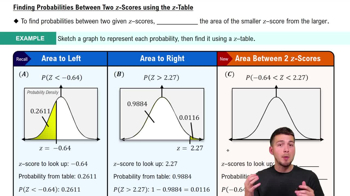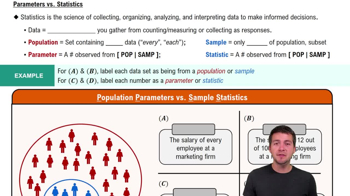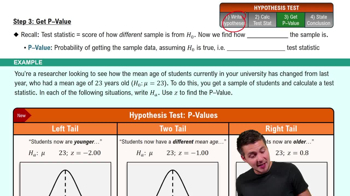Two-Way Anova If we have a goal of using the data given in Exercise 1 to (1) determine whether the femur side (left, right) has an effect on the crash force measurements and (2) to determine whether the vehicle size has an effect on the crash force measurements, should we use one-way analysis of variance for the two individual tests? Why or why not?
Table of contents
- 1. Intro to Stats and Collecting Data1h 14m
- 2. Describing Data with Tables and Graphs1h 55m
- 3. Describing Data Numerically2h 5m
- 4. Probability2h 16m
- 5. Binomial Distribution & Discrete Random Variables3h 6m
- 6. Normal Distribution and Continuous Random Variables2h 11m
- 7. Sampling Distributions & Confidence Intervals: Mean3h 23m
- Sampling Distribution of the Sample Mean and Central Limit Theorem19m
- Distribution of Sample Mean - Excel23m
- Introduction to Confidence Intervals15m
- Confidence Intervals for Population Mean1h 18m
- Determining the Minimum Sample Size Required12m
- Finding Probabilities and T Critical Values - Excel28m
- Confidence Intervals for Population Means - Excel25m
- 8. Sampling Distributions & Confidence Intervals: Proportion1h 12m
- 9. Hypothesis Testing for One Sample3h 29m
- 10. Hypothesis Testing for Two Samples4h 50m
- Two Proportions1h 13m
- Two Proportions Hypothesis Test - Excel28m
- Two Means - Unknown, Unequal Variance1h 3m
- Two Means - Unknown Variances Hypothesis Test - Excel12m
- Two Means - Unknown, Equal Variance15m
- Two Means - Unknown, Equal Variances Hypothesis Test - Excel9m
- Two Means - Known Variance12m
- Two Means - Sigma Known Hypothesis Test - Excel21m
- Two Means - Matched Pairs (Dependent Samples)42m
- Matched Pairs Hypothesis Test - Excel12m
- 11. Correlation1h 6m
- 12. Regression1h 50m
- 13. Chi-Square Tests & Goodness of Fit1h 57m
- 14. ANOVA1h 57m
9. Hypothesis Testing for One Sample
Steps in Hypothesis Testing
Problem 12.2.5
Textbook Question
Car Crash Test Measurements If we use the data given in Exercise 1 with two-way analysis of variance and a 0.05 significance level, we get the accompanying display. What do you conclude?

 Verified step by step guidance
Verified step by step guidance1
Step 1: Understand the context of the problem. This is a two-way ANOVA test, which is used to analyze the effect of two independent variables (factors) on a dependent variable, as well as their interaction. The table provides the results of the analysis, including degrees of freedom (DF), sum of squares (SS), mean square (MS), F-statistic, critical F-value, and P-value for each source of variation.
Step 2: Interpret the interaction row. The interaction term tests whether the two factors interact significantly. Compare the P-value (0.01028) to the significance level (0.05). If the P-value is less than 0.05, conclude that there is a significant interaction effect between the two factors.
Step 3: Interpret the row variable. This term tests the main effect of the row variable (one of the factors). Compare the P-value (0.14832) to the significance level (0.05). If the P-value is greater than 0.05, conclude that the row variable does not have a significant main effect.
Step 4: Interpret the column variable. This term tests the main effect of the column variable (the other factor). Compare the P-value (0.01084) to the significance level (0.05). If the P-value is less than 0.05, conclude that the column variable has a significant main effect.
Step 5: Summarize the conclusions. Based on the P-values, there is a significant interaction effect between the two factors, no significant main effect for the row variable, and a significant main effect for the column variable. These conclusions should guide further analysis or decision-making.
 Verified video answer for a similar problem:
Verified video answer for a similar problem:This video solution was recommended by our tutors as helpful for the problem above
Video duration:
6mPlay a video:
Was this helpful?
Key Concepts
Here are the essential concepts you must grasp in order to answer the question correctly.
Two-Way ANOVA
Two-way ANOVA is a statistical method used to determine the effect of two independent categorical variables on a continuous dependent variable. It assesses not only the individual impact of each factor but also the interaction between them. This technique helps in understanding how different groups compare and whether their means are significantly different.
Recommended video:
Guided course

Probabilities Between Two Values
F-Statistic
The F-statistic is a ratio used in ANOVA to compare the variance between group means to the variance within the groups. A higher F-statistic indicates a greater disparity between the group means relative to the variability within the groups, suggesting that at least one group mean is significantly different from the others. It is crucial for determining the significance of the results.
Recommended video:
Guided course

Parameters vs. Statistics
P-Value
The p-value is a measure that helps determine the significance of the results in hypothesis testing. It indicates the probability of observing the data, or something more extreme, assuming the null hypothesis is true. A p-value less than the significance level (e.g., 0.05) suggests that the null hypothesis can be rejected, indicating a statistically significant effect.
Recommended video:
Guided course

Step 3: Get P-Value

 6:21m
6:21mWatch next
Master Step 1: Write Hypotheses with a bite sized video explanation from Patrick
Start learningRelated Videos
Related Practice
Textbook Question
